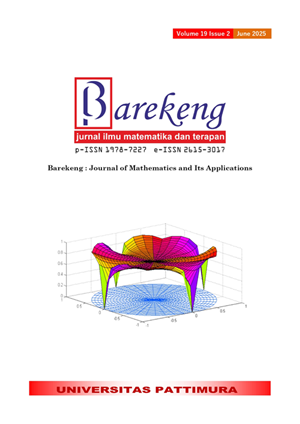SOLUTION OF FULLY FUZZY NONLINEAR EQUATION SYSTEMS USING GENETIC ALGORITHM
Abstract
A system of nonlinear equations is a collection of several interrelated non-linear equations. Currently, systems of nonlinear equations are used not only on crisp but also on fuzzy numbers. A fuzzy number is an ordered pair function that has a degree of membership [0,1]. Meanwhile, a fully fuzzy system of equations is a system of equations that applies fuzzy number arithmetic operations. The solution of non-linear equation systems is usually complicated to solve analytically, so numerical methods are used as an alternative to solve these problems. In this research, the steps to find the solution of nonlinear fully fuzzy equation systems using genetic algorithms are studied, which in the solution process is based on the theory of evolution and natural selection. The solution steps taken are first converting the fully fuzzy system of equations into a system of crisp equations, next constructing the system of strict equations as a multi-objective optimization problem, and lastly solving the optimization problem using a genetic algorithm which includes initialization, evaluation, selection, crossover, and mutation. As illustrations, several cases of nonlinear fully fuzzy and dual fully fuzzy systems of equations on triangular fuzzy numbers and trapezoidal fuzzy numbers are given. The approximate solutions obtained using genetic algorithms produce solutions that are close to their analytic solutions.
Downloads
References
C. Grosan and A. Abraham, “A NEW APPROACH FOR SOLVING NONLINEAR EQUATIONS SYSTEMS,” IEEE Trans. Syst. Man, Cybern. - Part A Syst. Humans, vol. 38, no. 3, pp. 698–714, May 2008, doi: 10.1109/TSMCA.2008.918599.
C. C. Marzuki and Herawati, “PENYELESAIAN SISTEM PERSAMAAN LINEAR FULLY FUZZY MENGGUNAKAN METODE ITERASI JACOBI,” J. Sains Mat. dan Stat., vol. 1, no. 1, pp. 1–7, 2015.
J. . Dijkman, H. van Haeringen, and S. . de Lange, “FUZZY NUMBERS,” J. Math. Anal. Appl., vol. 92, no. 2, pp. 301–341, Apr. 1983, doi: 10.1016/0022-247X(83)90253-6.
A. R. Permata and Arnellis, “PENYELESAIAN SISTEM PERSAMAAN LINEAR FUZZY MENGGUNAKAN METODE DEKOMPOSISI CROUT,” J. Math. UNP, vol. 3, no. 2, pp. 20–27, 2018.
C. Mangla, M. Ahmad, and M. Uddin, “SOLVING SYSTEM OF NONLINEAR EQUATIONS USING GENETIC ALGORITHM,” J. Comput. Math. Sci., vol. 10, no. 4, pp. 877–886, Apr. 2019, doi: 10.29055/jcms/1072.
David E. Goldberg, GENETIC ALGORITHMS IN SEARCH, OPTIMIZATION AND MACHINE LEARNING, 1st ed. Addison-Wesley Professional, 1989.
J. E. Simarmata and F. Mone, “IMPLEMENTATION OF GENETIC ALGORITHM BASED ON JAVASCRIPT IN OBJECT ROUTING SHORTEST TOUR ON TIMOR ISLAND,” vol. 17, no. 1, pp. 545–558, 2023.
M. I. Abyan, A. Nuryaman, B. H. Jihad, S. F. Junjunan, and A. Asmiati, “DESIGN OPTIMIZATION OF PROPELLANT GRAIN AND NOZZLE CONTOUR TO IMPROVE PERFORMANCE OF SOLID ROCKET PROPULSION,” J. Eng. Technol. Sci., vol. 54, no. 5, p. 220508, Sep. 2022, doi: 10.5614/j.eng.technol.sci.2022.54.5.8.
D. Gladiola, R. Menufandu, R. Fitriani, and E. Sumarminingsih, “ESTIMATION OF MAXIMUM LIKELIHOOD WEIGHTED LOGISTIC ( CASE STUDY : INDIVIDUAL WORK STATUS IN MALANG CITY ),” vol. 17, no. 1, pp. 487–494, 2023.
J. Lu and S.-C. Fang, “SOLVING NONLINEAR OPTIMIZATION PROBLEMS WITH FUZZY RELATION EQUATION CONSTRAINTS,” Fuzzy Sets Syst., vol. 119, no. 1, pp. 1–20, Apr. 2001, doi: 10.1016/S0165-0114(98)00471-0.
M. H. Mashinchi, M. R. Mashinchi, and S. M. H. J. Shamsuddin, “A GENETIC ALGORITHM APPROACH FOR SOLVING FUZZY LINEAR AND QUADRATIC EQUATIONS,” Int. J. Appl. Math. Comput. Sci., vol. 4, no. 4, pp. 185–189, 2007.
A. Kumar, Neetu, and A. Bansal, “A NEW METHOD TO SOLVE FULLY FUZZY LINEAR SYSTEM WITH TRAPEZOIDAL FUZZY NUMBERS,” Can. J. Sci. Eng. Math., vol. 1, no. 3, pp. 45–56, 2010.
P. Guchhait, M. Kumar Maiti, and M. Maiti, “A PRODUCTION INVENTORY MODEL WITH FUZZY PRODUCTION AND DEMAND USING FUZZY DIFFERENTIAL EQUATION: AN INTERVAL COMPARED GENETIC ALGORITHM APPROACH,” Eng. Appl. Artif. Intell., vol. 26, no. 2, pp. 766–778, Feb. 2013, doi: 10.1016/j.engappai.2012.10.017.
S. Gemawati, I. Nasfianti, Mashadi, and A. Hadi, “A NEW METHOD FOR DUAL FULLY FUZZY LINEAR SYSTEM WITH TRAPEZOIDAL FUZZY NUMBERS BY QR DECOMPOSITION,” J. Phys. Conf. Ser., vol. 1116, p. 022011, Dec. 2018, doi: 10.1088/1742-6596/1116/2/022011.
A. Ghodousian, M. Naeeimi, and A. Babalhavaeji, “NONLINEAR OPTIMIZATION PROBLEM SUBJECTED TO FUZZY RELATIONAL EQUATIONS DEFINED BY DUBOIS-PRADE FAMILY OF T-NORMS,” Comput. Ind. Eng., vol. 119, no. August 2017, pp. 167–180, 2018, doi: 10.1016/j.cie.2018.03.038.
A. H. Hamamoto, L. F. Carvalho, L. D. H. Sampaio, T. Abrão, and M. L. Proença, “NETWORK ANOMALY DETECTION SYSTEM USING GENETIC ALGORITHM AND FUZZY LOGIC,” Expert Syst. Appl., vol. 92, pp. 390–402, Feb. 2018, doi: 10.1016/j.eswa.2017.09.013.
Z. Deswita and Mashadi, “ALTERNATIVE MULTIPLYING TRIANGULAR FUZZY NUMBER AND APPLIED IN FULLY FUZZY LINEAR SYSTEM,” Am. Sci. Res. J. Eng. Technol. Sci., vol. 56, no. 1, pp. 113–123, 2019.
A. Jafarian and R. Jafari, “A NEW COMPUTATIONAL METHOD FOR SOLVING FULLY FUZZY NONLINEAR MATRIX EQUATION,” Int. J. Fuzzy Comput. Model., vol. 2, no. 4, pp. 275–285, 2019, doi: 10.1007/978-3-319-98443-8_46.
Z. La, A. Eka, and D. Aziz, “PENYELESAIAN SISTEM PERSAMAAN FULLY FUZZY NON LINEAR MENGGUNAKAN METODE NEWTON RAPHSON GANDA,” J. Math. Theory Appl., vol. 5, no. 2, pp. 67–73, Oct. 2023, doi: 10.31605/jomta.v5i2.2876.
L. Zakaria, W. Megarani, A. Faisol, A. Nuryaman, and U. Muharramah, “COMPUTATIONAL MATHEMATICS: SOLVING DUAL FULLY FUZZY NONLINEAR MATRIX EQUATIONS NUMERICALLY USING BROYDEN’S METHOD,” Int. J. Math. Eng. Manag. Sci., vol. 8, no. 1, pp. 60–77, Feb. 2023, doi: 10.33889/IJMEMS.2023.8.1.004.
W. Megarani and L. Zakaria, “A NUMERICAL SOLUTION FOR FULLY FUZZY NONLINEAR SYSTEMS BASED ON THE BROYDEN METHOD,” 2024, p. 030020. doi: 10.1063/5.0208306.
A. U. Moyi, J. Lawal, A. F. Jameel, S. M. Ibrahim, and A. B. Disu, “A NEW APPROACH FOR SOLVING SINGULAR DUAL FUZZY NONLINEAR EQUATIONS,” 2024, p. 020021. doi: 10.1063/5.0225306.
U. Omesa et al., “AN EFFICIENT HYBRID CONJUGATE GRADIENT ALGORITHM FOR SOLVING INTUITIONISTIC FUZZY NONLINEAR EQUATIONS,” Basic Appl. Sci. - Sci. J. King Faisal Univ., pp. 1–6, 2023, doi: 10.37575/b/sci/220041.
I. M. Sulaiman, M. Mamat, M. Malik, K. S. Nisar, and A. Elfasakhany, “PERFORMANCE ANALYSIS OF A MODIFIED NEWTON METHOD FOR PARAMETERIZED DUAL FUZZY NONLINEAR EQUATIONS AND ITS APPLICATION,” Results Phys., vol. 33, p. 105140, Feb. 2022, doi: 10.1016/j.rinp.2021.105140.
S. M. Ibrahim, M. Mamat, and P. L. Ghazali, “SHAMANSKII METHOD FOR SOLVING PARAMETERIZED FUZZY NONLINEAR EQUATIONS,” An Int. J. Optim. Control Theor. Appl., vol. 11, no. 1, pp. 24–29, Dec. 2020, doi: 10.11121/ijocta.01.2021.00843.
L. J. Eshelman and J. D. Schaffer, “REAL-CODED GENETIC ALGORITHMS AND INTERVAL-SCHEMATA,” vol. 2, pp. 187–202, Jan. 1993, doi: 10.1016/B978-0-08-094832-4.50018-0.
Copyright (c) 2025 Fatimatuzzahra Fatimatuzzahra, Aang Nuryaman, La Zakaria, Agus Sutrisno

This work is licensed under a Creative Commons Attribution-ShareAlike 4.0 International License.
Authors who publish with this Journal agree to the following terms:
- Author retain copyright and grant the journal right of first publication with the work simultaneously licensed under a creative commons attribution license that allow others to share the work within an acknowledgement of the work’s authorship and initial publication of this journal.
- Authors are able to enter into separate, additional contractual arrangement for the non-exclusive distribution of the journal’s published version of the work (e.g. acknowledgement of its initial publication in this journal).
- Authors are permitted and encouraged to post their work online (e.g. in institutional repositories or on their websites) prior to and during the submission process, as it can lead to productive exchanges, as well as earlier and greater citation of published works.






1.gif)



